How to Pick WordPress Ecommerce Plugins: Your Top 9 Choices
Maddy Osman


How to Pick WordPress Ecommerce Plugins: Your Top 9 Choices
Get The Print Version
Tired of scrolling? Download a PDF version for easier offline reading and sharing with coworkers.
A link to download the PDF will arrive in your inbox shortly.
Did you know that there are over 50,000 plugins in the WordPress plugin repository?
For many, this number can seem more overwhelming than exciting. With so many options, how do you pick the best plugins for your specific needs?
Furthermore, how can you trust that a new plugin will play nice with your existing WordPress configuration?
In this situation, popularity can be indicative of quality. Popular plugins are also easier for plugin developers to justify devoting resources to supporting across a variety of compatibility factors.
Then again, plugins with a large user base become targets for hacking attempts that focus on plugin security vulnerabilities. Of course, the same can be said about poorly built plugins with few users (and even less compatibility support).
Either way, yet another important factor for choosing plugins is security — and how a plugin developer publically responds to a situation where a hacking attempt was successful.
This need becomes increasingly more important when considering WordPress ecommerce plugins, as they process especially sensitive personal data.
All else equal, the most important consideration for picking WordPress ecommerce plugins is ultimately about whether a plugin fits your specific needs.
What to Do Before Picking a Plugin to Activate Ecommerce for WordPress
Before you choose the plugins and extensions that will power your ecommerce store, you must build a solid foundation for your WordPress website.
These are non-negotiable elements:
1. A performance WordPress web host.
Technically, you can get away with a cheap plan but since page speed is such a critical component of a good ecommerce experience (it’s also a Google ranking signal), premium-tier service is worth the investment.
A reputable web host can also ensure limited downtime (if any) and offer high bandwidth to handle high traffic, so that you never miss a sale.
2. An SSL certificate.
As mentioned, ecommerce shops process both personal and financial information, so tight WordPress security is a must. An SSL certificate provides a type of encryption that secures data between the web host and web server.
You can tell that a website is secure if it effectively incorporates “https” into the URL. If you’re using Google Chrome, it will actually warn you on the address bar if the website is not secure.
Installing an SSL certificate and properly redirecting URLs from HTTP to HTTPS is how to enable HTTPS.
Is there a reason to enable HTTPS besides enabling and communicating website security?
I’m so glad you asked.
Yes — HTTPS is a Google search ranking signal.
What & Where Will You be Selling?
Another initial step to take before digging into available WordPress ecommerce plugin options is deciding on what you’re going to sell and how you’re going to facilitate the transaction (if you haven’t already).
1. Digital or physical products?
You can sell both physical and digital products online.
Some WordPress ecommerce plugins support both types of sales, while there are some that specialize in just one.
There are also plugins and platforms that support dropshipping, if you don’t want to have to deal with holding inventory and handling fulfillment.
2. What countries will you sell to?
Some WordPress ecommerce plugins offer default payment gateways that come already installed.
Most of the top ecommerce plugins support the most popular/international-friendly options: Paypal, Stripe, and Authorize.
But all of these popular payment gateways have limitations, depending on the specific countries you’re selling to.
Do your research before settling on a payment gateway/ecommerce plugin stack.
4 Important Factors To Consider When Choosing An Ecommerce Plugin for Your WordPress Site
The following factors will help you separate the good from the bad when it comes to WordPress ecommerce plugins:
1. The current supported WordPress version.
New WordPress versions are constantly being released, which creates compatibility problems for plugin developers who can’t keep up.
As a general rule, good plugins are frequently updated.
It is important that they stay up-to-date with the latest WordPress core version to avoid the possibility of a compatibility issue breaking your website.
WordPress issues warnings to users attempting to download outdated plugins — those that haven’t been updated within the past two years.
2. The overall impact on page speed.
Plugins aren’t always made with economical bandwidth (CPU usage) in mind — some can seriously slow down your website.
Before installing a WordPress ecommerce plugin, check out publicly posted plugin reviews (then try saying that 3 times, fast).
Besides those available on the WordPress Plugin Directory, a quick Google search with “[Plugin Name] Review” can be similarly enlightening.
3. Existence of community.
Many of the top WordPress plugins have rabid fans who are eager to sing the praises of these useful tools.
These individuals can be great resources for troubleshooting uncommon issues not thoroughly addressed in plugin support documentation.
There are a few ways to determine community around WordPress ecommerce plugins:
Check the number of downloads to determine a plugin’s popularity over time. Compare total downloads against the number of active installations to determine a rough churn rate across various plugin options. Churn can indicate a promise not fulfilled with use.
Use the WordPress Plugin Directory to find the aforementioned numbers for each plugin that you’re considering. If the plugin is not listed here, it may only be offered as a premium (paid) tool. If that’s not the case, that’s a definite red flag about the plugin’s quality. WordPress.org lists the following as potential problem areas that prevent a plugin from being listed on the Plugin Directory: security, documentation, and presentation. Keep in mind, though, that some of the most reputable plugins in the world are not on this directory. If you have any concerns about a plugin (on the directory or not), reach out to the commercial vendor and ask. No response there is the biggest red flag.
Don’t rely on statistics about popularity, alone — make sure to read a few reviews to understand what it’s like to actually use the plugin. Reviews can help you understand whether certain desired plugin features will be problematic to implement. Check to see if/how plugin developers respond to bad reviews and if they fix issues that get mentioned by reviewers.
4. Backend support.
Every once in a while, plugins crash, payment systems fail, and caches don’t cache.
Determine if available plugin support will be enough for your needs — including the ability to pay for additional access to personalized/timely support.
Some plugin developers can even make changes for you directly in WordPress, cutting out the middleman if you’d otherwise outsource the prescribed fix to a web developer.
The 9 Best Ecommerce Plugins for WordPress
Once you’ve determined the specific elements that match your needs, it’s time to decide between the following WordPress ecommerce plugins:
BigCommerce for WordPress.
WooCommerce.
Shopify.
Ecwid Ecommerce Shopping Cart.
Easy Digital Downloads.
Cart66 Cloud
WP eCommerce
Jigoshop eCommerce
WP EasyCart
1. BigCommerce for WordPress

BigCommerce is one of the largest managed ecommerce platforms in the world, today.
The platform offers web hosting, payment gateway integration (including PCI-compliance, payment gateways, tax solutions, email marketing solutions and more), 24/7 customer support via chat, phone or email, and other important tools you’ll need to launch an online store.
BigCommerce recently launched a WordPress plugin that effectively creates a headless commerce solution, incorporating the WordPress CMS (content management system).
Everything you need to operate a profitable ecommerce shop is included with the use of this plugin in tandem with a BigCommerce account — no additional extensions necessary.
The BigCommerce WordPress plugin is still somewhat new to the market as of this article’s publication but new stores incorporating this headless commerce solution are popping up every day!
If you’re looking for live site examples, check out Carluccio’s.
BigCommerce plans start at $39/month.
2. WooCommerce

An old standby, WooCommerce is currently the most popular WordPress ecommerce plugin.
This likely has something to do with the fact that WooCommerce is powerful, free, and is owned by Automattic, one of the most influential companies in the WordPress ecosystem.
WooThemes (the original creators of WooCommerce) was acquired by Automattic in 2015.
Because WooThemes was acquired by Automattic specifically, WooCommerce’s popularity increased to the point that WooCommerce powers roughly 20% of all ecommerce websites online.
Just like WordPress, WooCommerce is:
Easy to use.
Flexible. You can sell both physical and digital products, integrate WooCommerce with most payment providers, and you can customize your store according to your specific needs with an extensive library of themes and extensions (both paid and free).
Scalable. WooCommerce works, whether you’re selling 10 items or 10,000.
Free to use. As a trade-off, there is no plugin customer support (unless you purchase paid products). That said, you can rely on WooCommerces’s large network of users and contributors to help you when you’re in need.
3. Shopify.

Though it operates outside of the WordPress ecosystem, it’s still worth mentioning Shopify.
Technically, you can create a connection between Shopify and WordPress via their buy button — but it’s hardly as robust an option as their managed ecommerce platform.
Shopify is a stand-alone, managed ecommerce platform that enables even the most non-technical user to start, grow, and manage an online business.
Shopify is completely cloud-based, which means that you can run your ecommerce shop anywhere there’s an internet connection.
Shopify offers new users a 14-day free trial, and upon expiry, you’ll have to sign up for one of their paid plans (which start at $39/month).
You can add extra functionality to your store with Shopify apps.
4. Ecwid Ecommerce Shopping Cart

Ecwid Ecommerce Shopping Cart is another managed ecommerce platform for selling products online. It is similar to WooCommerce in terms of setup and in terms of high user ratings.
The main difference between these two options is that Ecwid can be used on any website, not just WordPress (including Facebook, Instagram, Wix, Joomla, and Weebly, among others).
Knowing this, one of the main benefits of using Ecwid is the ability to sell simultaneously on various channels.
The core plugin is free to use and the functionality is sufficient for small stores with up to 10 products.
As you grow, you’ll want to switch over to a paid subscription plan, which starts at $15/month and gives you access to features like the ability to create Instagram and Facebook shops, as well as a dedicated mobile app.
5. Easy Digital Downloads.
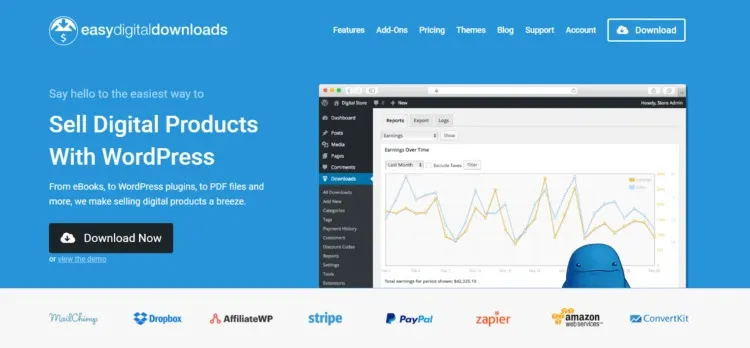
If you’re planning on selling digital products such as ebooks, audiobooks, and other PDF files, Easy Digital Downloads (EDD) might be the ideal WordPress ecommerce plugin for you.
Though WooCommerce offers functionality targeted at both digital and physical products, EDD specializes in facilitating digital product sales.
What’s great about EDD is that the core plugin is free to use, and once installed, you’ll have access to features like customer management, discount codes, and shopping cart management.
That said, you’ll likely want to upgrade to a paid plan (which start at $99/year) to take advantage of all EDD’s useful features and extensions.
6. Cart66 Cloud
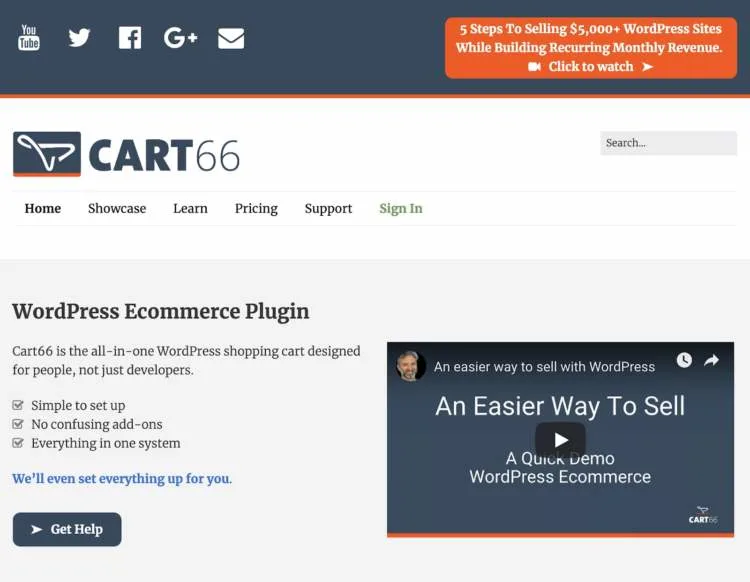
Cart66 Cloud’s appeal lies not in a complex technical backend but in a seamless front-end experience that’s accessible for those who want to start an ecommerce store but don’t have web development experience.
Unlike with WooCommerce, most of the necessary ecommerce functionality comes built-in — no need to go crazy buying extensions to make it work the way you want.
Cart66 Cloud is flexible enough to use for a number of different online payment scenarios: collecting donations, selling products, creating subscription payments, and more.
Curiously, Cart66’s pricing page mentions that they’re not currently accepting new accounts though their plugin is still active on the WordPress Plugin Directory.
7. WP eCommerce
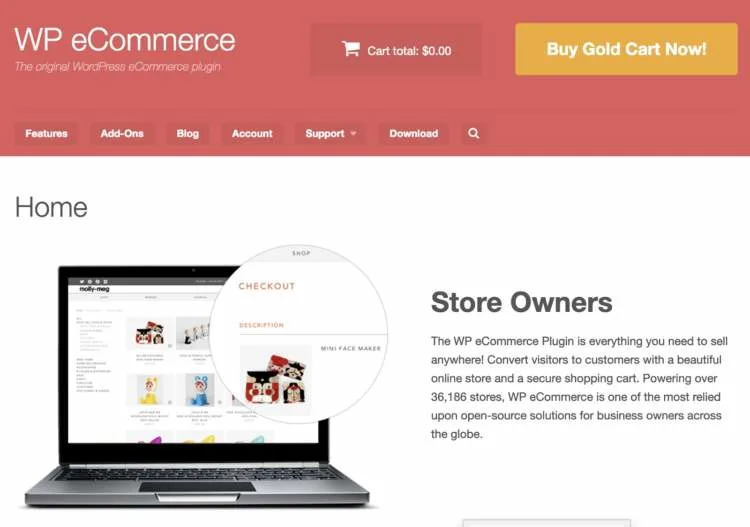
If you’ve already played around with WooCommerce, you’ll feel right at home when using WP Ecommerce — which has a look, feel, and paid extensions situation that mirrors the more well-known WordPress ecommerce plugin.
To determine if WP eCommerce right for you, you’ll want to come into picking a WordPress ecommerce plugin equipped with a list of non-negotiable feature needs.
There are some major differences between what WooCommerce offers for free versus as a paid extension and how WP eCommerce handles these same features in terms of free and paid options.
WP Ecommerce is free to use with a marketplace of paid add-ons available to extend its core functionality.
8. Jigoshop eCommerce
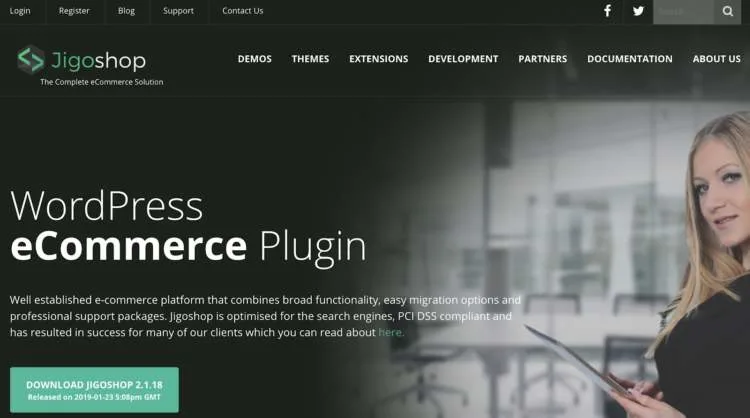
Much like the WordPress core code, Jigoshop is open-source, which means that anyone can extend it for their own purposes without being on the hook for licensing fees.
Originally launched in 2011, it was the first WordPress ecommerce plugin to market and paved the way for all other options mentioned on this list.
You might be interested to know that founding WooThemes team members Mike Jolley and Jay Koster were hired to create WooCommerce after initially working on development for Jigoshop.
As such, the link between these two popular WordPress ecommerce plugins is clear in terms of basic functionality — though many find Jigoshop to provide a better user experience.
Like WooCommerce, you can use it to sell a range of digital and physical products.
Jigoshop is free to use with paid themes and extensions available.
9. WP EasyCart

Like Cart66 Cloud, WP EasyCart was created for people with simple needs, who want to launch an ecommerce store without having to spend a lot of money or time on getting up to speed with WordPress web development.
It integrates with the same tools most small business users already use and love, like Quickbooks and MailChimp.
As with many of the top WordPress ecommerce plugins mentioned here, you can use it to sell both digital and physical products.
There’s a free plan available, with a premium level of service offered at a reasonable $99/year for access to all extensions.
Additional Plugins to Consider for Your WordPress Store
The following represent some of the best plugins to support WordPress ecommerce functionality:
HubSpot
Yoast SEO
WP Rocket
Wordfence Security
1. HubSpot
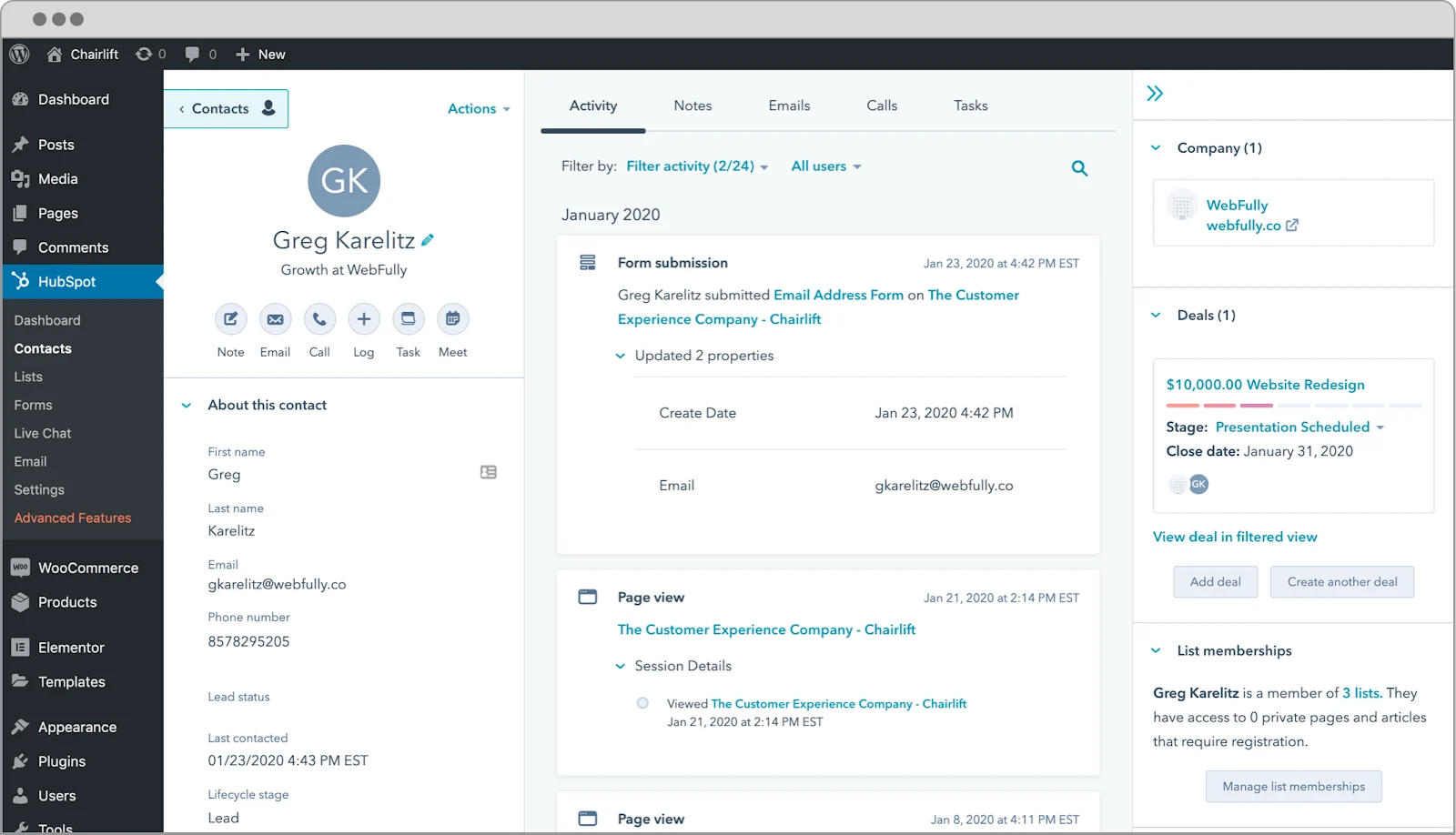
Over 100,000 websites trust the free HubSpot WordPress plugin to add all-in-one marketing functionality to their WordPress site. And we think it’s a must-have plugin for e-Commerce sites looking to engage and convert visitors.
With HubSpot, you can easily add live chat, chatbots, forms, and popups to your pages — as well as send marketing emails, store contacts in a CRM, and see analytics about all of your efforts. It’s quick to install, easy-to-use, and proves to be an incredibly useful plugin. Not only do you get all this functionality from within your WordPress dashboard, the plugin saves you from having to install multiple plugins for each marketing function (speeding up your site).
2. Yoast SEO
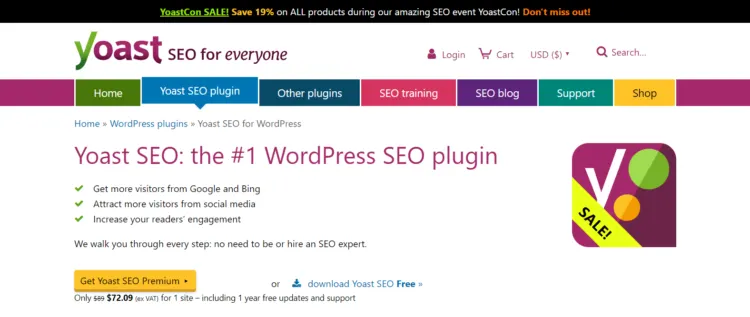
Yoast SEO is one of the most popular WordPress products, for good reason.
It may not be an ecommerce plugin in the strictest sense, but it’s a necessary supplement — especially if you’re establishing an ecommerce store on WordPress.
Yoast SEO helps WordPress sites with important onsite SEO and technical SEO maintenance, which is necessary if you intend to drive traffic (and sales) from search engines.
Yoast is free to use but the Premium versions unlock lots of additional value and functionality. Yoast SEO Premium starts at $89 for a one site license (there’s also a Yoast plugin for WooCommerce).
3.WP Rocket
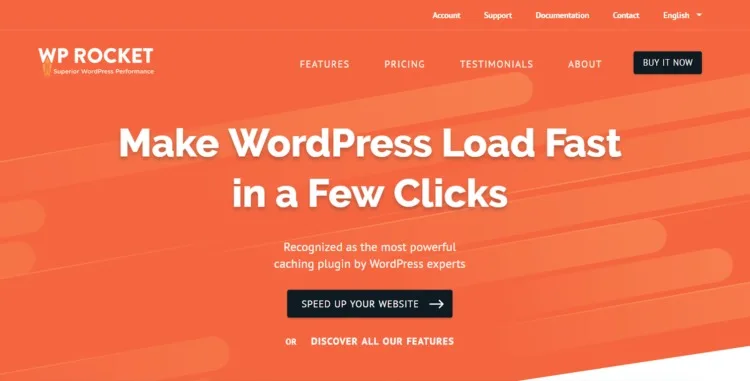
Optimizing your website for WordPress speed is important, and a caching plugin like WP Rocket will come in handy for minimizing page load time.
WP Rocket supports both page and browser caching, which means that when your visitors leave one page for another, the static content does not have to be re-loaded.
It also supports GZIP compression (this optimizes the rendering of web browsers, which saves bandwidth), cache and sitemap preloading, and database optimization.
Another thing that makes WP Rocket different from other popular caching plugins is that it fully supports ecommerce needs, automatically excluding the checkout and cart pages from caching if you’re using supported WordPress ecommerce plugins.
Pricing for a one site WP Rocket license starts at $49, with bulk discounts available.
4. Wordfence Security
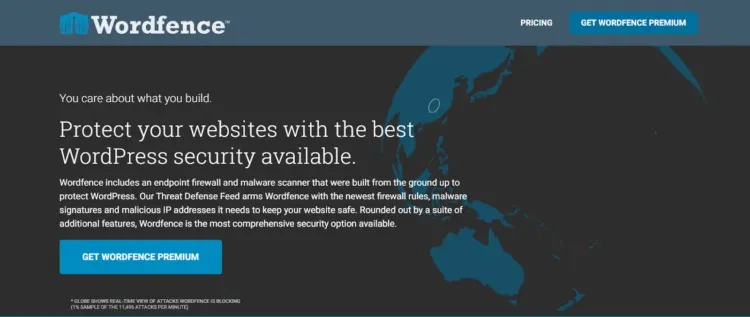
Wordfence Security is another must-have plugin for WordPress ecommerce websites.
It offers a comprehensive firewall and security scanner that helps improve website security.
Wordfence Security costs $99 for a one website license, with bulk discounts available.
Upgrading to the premium version unlocks features like realtime IP blacklist, firewall rule updates, and malware signature updates — all important for blocking potentially costly hacking attempts and downtime.
When To Pull The Plug(in)
Over time, plugins can pile up on the backend of your WordPress website. Some of them may be slowing down your website in ways you haven’t yet realized.
If you’re experiencing slow load times, weird glitches, and other major user experience issues, it may be time to re-evaluate your current WordPress plugin mix.
Swap out problematic plugins for better options with this process:
1. Find the bad plugin.
There are many ways a plugin can be bad for your website, including:
It slows down your site.
It isn’t compatible with your other plugins.
It makes your site glitchy.
It makes your site vulnerable to attacks.
To get rid of a bad plugin, you must first identify it.
You can use a plugin like P3 (Plugin Performance Profiler) to determine major offenders.
To avoid major plugin problems, remember to:
Constantly update your plugins.
On that note, keep WordPress and your WordPress theme up-to-date. A WordPress maintenance service like WP Buffs can help you keep versions up-to-date while fixing any compatibility issues that pop up.
Remove and uninstall any plugin you don’t need. Even when it’s not active, an installed plugin can still become the target of a malware attack. If you’re done testing out a plugin and decide you don’t want it, delete it. You can uninstall the errant plugin via dashboard or FTP. Note that deleting plugins this way may leave behind tables and rows on your WordPress database, which may accumulate a lot of data and eventually slow your website down. Kinsta shares the proper way to uninstall a WordPress plugin.
2. Backup your website.
Create backups of your website for both before and after you delete an errant plugin.
This way, if something goes wrong, you can immediately revert back to the last stable version of your live website.
Better yet, use a staging website to model changes before pushing them live.
3. Switch out a bad plugin for a better replacement.
If an errant plugin supports an irreplaceable function (like website security), it should be replaced immediately.
Look for a plugin that’s compatible with your other plugins.
4. Test the new plugin.
WPMU DEV offers several ideas to troubleshoot your newly installed plugin.
5. Go live.
Once you’re sure all plugins are playing nice with each other, your WordPress theme, and (ideally) the most up-to-date WordPress core software version (alternatively, whatever WordPress version you’re currently using), you can push your website changes live.
Final Thoughts: The Best WordPress Ecommerce Plugins: Your Top Choices
There’s nothing basic about the process around choosing the right WordPress ecommerce plugin for your needs.
To quote Mad-Eye Moody, “Constant vigilance!” is necessary not only for initially picking a plugin but also to determine if it’s compatible with your website over time.

A basic litmus test for determining plugin quality involves checking for frequent updates, good reviews, support, and whether it is compatible with existing WordPress configuration.
What other questions do you have about picking WordPress ecommerce plugins? Share your thoughts by tweeting at @BigCommerce!

Maddy Osman is a writer for BigCommerce specializing in search engine optimized content and deep dive articles that help readers and companies achieve their goals. You can learn more about her process at The-Blogsmith and follow her on Twitter: : @MaddyOsman